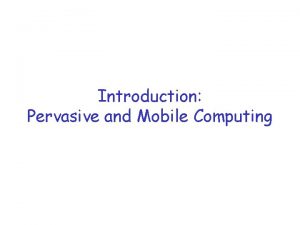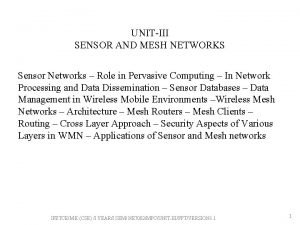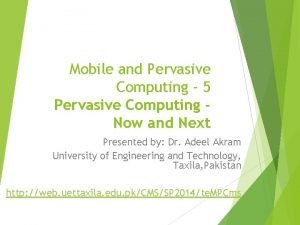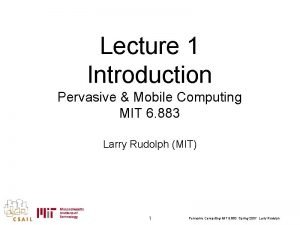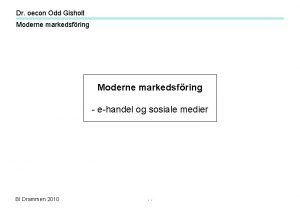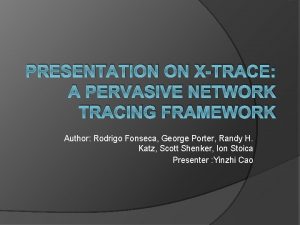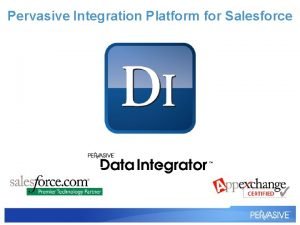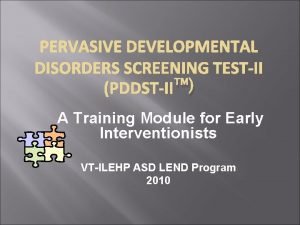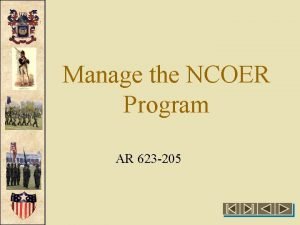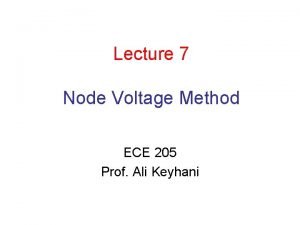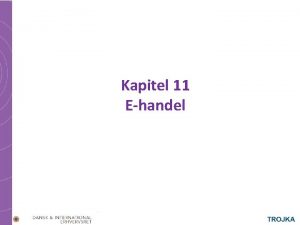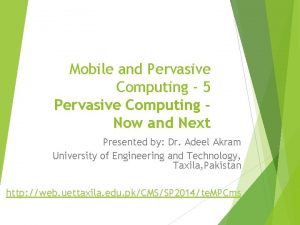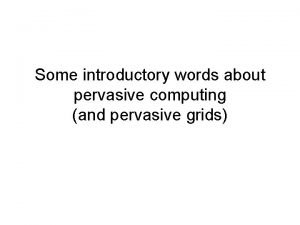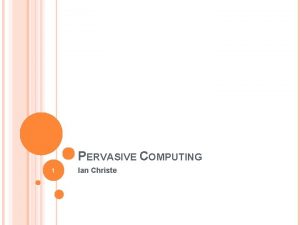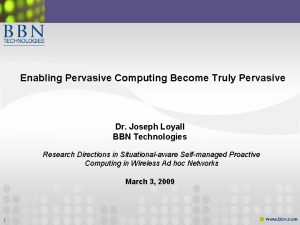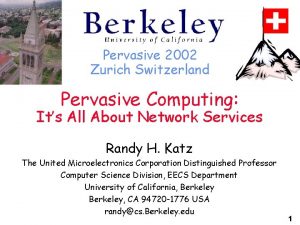Lo 205 EHandel Pervasive Computing Class 23 Pervasive


















- Slides: 18

Lo 205: E-Handel: Pervasive Computing Class 23 Pervasive Computing April 03, 2001 Judith Molka-Danielsen Reference: Daniel Amor, ”The E-business (R)evolution”, Hewlett-Packard Professional Books, 2000, pp 549 -573.

Enabling Technologies Internet - is becoming a universal network Access - to the Internet through mobile phones or TVs. . . Internet appliances take the functionality of a PC in a device. Pervasive Computing brings the functionality of web into devices and also provides services from the device into other entities on the Internet.

Direction of Pervasive Computing Today web sites (Amazon. com) provide services (sell books) All support services must be implemented on their site. The web site is proprietary, massive and costly to maintain. These (inventory mgmt, distribution, billing, store front) are not part of their core business. Want to Outsource these services. Need Pervasive Computing.

Outsourcing of Services on the Internet Sevices, like billing, can be divided into smaller tasks. If the customers printers have web access, then bills can be printed out at the customers site, saving mailing costs. Or the bill can be sent to the customers ERP system and paid automatically. • Internet is used for the communications channel. • HTML/XML is used for data exchange between services. • Another layer is needed to: (1)enable services to accept other services, (2)connect and create meta-services, (3)announce services on Internet.

Who offers the future? Sun and its Jini technology promote universal networks or pervasive computing. Also, Hewlett-Packard, IBM, Lucent Technologies and Microsoft. Goal: to connect everything to one ubiquitous network, from a super computer to a light switch.

Device-to-device Communication Lowest layers of the architecture say how devices are to be connected to the network. Connection phases (establish, transport, and termination). Higher layers say how the information of the service is structured. Chai is Hewlett-Packard’s implementation of the Java Virtual Machine. (Means ”tea” in many languages or ”life” in Hebrew. ) Chai. VM accounts for differences in embedded devices (like printers or palmtops). Chai. Server allows web-based connections to other devices on the network. It is a small (200 -400 k), scalable web server for embedded devices.

Device-to-device Communication Devices with a Chai. Server can have their own web pages. They can contain info on the service-state of the device, or manage security and administration of the device. Appliances could be updated using plug-ins called Chailets. • They are objects written in Java. • They communicate by HTTP through a web browser, SMTP, or the Chai. Server Notifier Chailet. • They can be loaded at runtime. • They have their own URL. • They can be used to generate dynamic web pages. • http: //www. chai. hp. com

Device-to-device Communication Inferno by Lucent Technologies has a small OS, was designed for smart-phones. Supports languages: Limbo and Personal Java. Inferno is a distributed network operating system that models all resources as files. Has built-in encryption mechanisms for communication between devices. It was made for the telephony domain. In a computing framework it needs dynamic extensibility, scalable lookup, brokerage services, ID through attribute descriptions, intermachine trust model. Inferno basically allows devices to work on a network, but does not allow other devices to find/use these devices.

Device-to-device Communication The Inferno system is backed by an infrastructure. Services Lucent suggests are: • Pay-per-view films on set top boxes • E-mail by mobile phones (Philips has inferno enabled mobile phone, IS-2630) • Firewall concept where the network devices talk to the firewall software on a server. Inferno is mature (ver. 2. 3) and runs on most OS. It is device-centric so that it is difficult to coordinate complex services (many devices, many types of devices). http: //www. lucent-inferno. com/

Device-to-device Communication Universal Plug and Play (UPn. P) by Microsoft is an extension of the Pn. P hardware recognition system in Windows 95. Devices announce themselves and their capabilities when they plug into the network. UPn. P works with smart objects (light switches, volume controls, telephones, computers, devices not currently on the network). UPn. P is built on the underlying technology. Only works with devices that are based on the a Microsoft OS. It cooperates with Jini technology.

Device-to-device Communication Jini is by Sun Microsystems. It allows devices to broadcast the services it offers to all other devices in a community that can be used by members of the network. • Impromptu communities are created when 2 or more devices create a network to share their services. No prior knowledge of devices needed. Uses an object-oriented, distributed computing approach. • Does not scale over 200 objects, expects consistent states and all members must share a single clock, does not function across firewalls, only speaks Java, uses only global names for devices. • Jini features Federations, loosely connected devices regulated in a decentralized manor. Security is loose. Jini can be fitted to a JVM but requires devices have an OS. One application is to cluster the processing power of computers on a network.

Information Exchange Information exchange, is the exchange of data between devices. This sits at the middle layer. This is the exchange between service provider and customer. (Attempts at Distributed OS. ) • Hewlett-Packard has Jet. Send for a global market • IBM has T Spaces is for home market LANs • Lucent has Inferno. Spaces, extends the Inferno name space to legacy applications, for a distributed computing environment. • Microsoft has Millenium, distributed OS to share tasks across a network. Goals: seamless distribution, global scale, fault tolerance, security, resource management and discovery. But based on COM, homogeneous central server environment. Data sits on many devices in different formats. The middle layer decides what format you will send the data in, when going between devices. Devices choose right format (printers, scanners, cameras).

Service Layer (Broadcasting) Top Layer is the Service Layer. Services broadcast their existance. Jini does this at the LAN level. E-Speak (or Fremont) by Hewlett-Packard scales to the Internet. It is a network middleware layer over an OS to make services independent of the OS. Concept: (Freemont - Install once, serve anywhere) (Java -write once, run anywhere). Fremont has protocols for negotiation, brokering, bidding, billing. Its architecture allows combined modular services (meta-services). Combine services from several devices to make a new service.

Service Layer (Broadcasting) Chai. Server allows devices to talk to each other, but does not say how. To create services, you must advertise, broker (handle sets of services, sets of data, sets of devices), compose, and maintain the service. Fremont can allow access to single services on an Intranet without compromising security. Instant extranets. It uses a Fire. Screen gateway service to push shared information to the external net. Fire. Screen connector interface for retrieving requests at the connector site. Gateway processes run on connector and consumer machines, check the consumer clients identity with files it can see.

Service Layer (Broadcasting) Electronic Service Brokers (ESB), are channels for the delivery of electronic services. They are next-generation portals. Customers can access services without buying the underlying infrastructure. Instead of buying applications, you rent them on a usage basis over the Internet E-Speak sits over Jini, Chai. Server or UPn. P. HP doesn’t care what OS or language is used for accessing the electronic services. E-Speak pilot sites: Uniscape, Captura and Helsinki Telephone.

The Vision E-Services: Hewlett-Packard seems to have a e-service strategy for the creation of specialized modular services to be accessed by people, businesses and devices. E-services can be combined automatically. Today (build proprietary services, massive, costly for each group): • Servers and browsers follow pre-defined processes. • Customers are enabled though the web, and businesses become customer centric (small bookshops must reach customers as Amazon did). • Extranets unify communities and save partners money. Next (web sites become un-important) Open Service Paradigm

The Vision Next (web sites become un-important) Open Service Paradigm Instead of (Do-it-yourself) it is (Do-it-for-me) Open services interfaces - services talk to each other without human intervention. All types of devices can be integrated into the eservice. B 2 B web sites will profit from the new paradigm. It will be easier to implement billing systems, automated supply-chain management, procurement solutions, modular ERP systems. This will be done by intelligent e-service systems. Give more flexibility for IT infrastructures. More efficient use of internal and external resources. Customers do not want monolithic systems. They can subscribe to the services they want to use. (Pay-per-use. )

The Future Standards are still developing. Winning technology unknown. Analogy: car and benzine station. The car does not search for the station. But you must know one is available, and go to it when the benzine is low. Production changes: built when customer pays. Spontaneous advertising: for what I need right now. Free-lancers can make a small brick that can be used by other service builders. (Lower the entry barrier for a start-up businesses. ) Quality of Service becomes more important than an implementation. Anyone can do the parts, how is the service?
 Pervasive computing wikipedia
Pervasive computing wikipedia Pervasive and mobile computing
Pervasive and mobile computing Pervasive computing ppt
Pervasive computing ppt Mobile and pervasive computing
Mobile and pervasive computing Pervasive and mobile computing
Pervasive and mobile computing Ehandel lager
Ehandel lager Odd gisholt
Odd gisholt Distributionskæde
Distributionskæde Conventional computing and intelligent computing
Conventional computing and intelligent computing Image trace makes white box
Image trace makes white box Orchastrate
Orchastrate Specific and pervasive boundaries for behavior
Specific and pervasive boundaries for behavior Pervasive developmental disorder screening test
Pervasive developmental disorder screening test Pdd disorder
Pdd disorder Melancholic features
Melancholic features Ar 623-2
Ar 623-2 205 binary
205 binary Non rated codes ncoer
Non rated codes ncoer Node voltage
Node voltage

